|
サイズ: 6529
コメント:
|
← 2018-01-09 13:30:52時点のリビジョン9 ⇥
サイズ: 6354
コメント:
|
| 削除された箇所はこのように表示されます。 | 追加された箇所はこのように表示されます。 |
| 行 1: | 行 1: |
| [English|[[SSHClient/WindowsGUI|Japanese]]] |
|
| 行 11: | 行 13: |
| As the first step, install the virtualization software called VirtualBox. Next, download the Linux virtual machine disk image, and register it with the VirtualBox. Finally, set up the Linux virtual machine. |
As the first step, install the virtualization software called Virtual''''''Box. Next, download the Linux virtual machine disk image, and register it with the Virtual''''''Box. Finally, set up the Linux virtual machine. |
| 行 25: | 行 27: |
| The setup program starts. Click the '''Next''' button. | The setup program starts. Click the ['''Next'''] button. |
| 行 29: | 行 31: |
| Customize the installation settings as required. Click the '''Next''' button. | Customize the installation settings as required. Click the ['''Next'''] button. |
| 行 33: | 行 35: |
| Choose the installation options as required. Click the '''Next''' button. | Choose the installation options as required. Click the ['''Next'''] button. |
| 行 37: | 行 39: |
| A message warning that the network connection will be interrupted is displayed. Click the '''Yes''' button. | A message warning that the network connection will be interrupted is displayed. Click the ['''Yes'''] button. |
| 行 41: | 行 43: |
| The final confirmation window before installation is displayed. Click the '''Install''' button. | The final confirmation window before installation is displayed. Click the ['''Install'''] button. |
| 行 45: | 行 47: |
| The dialog that confirms installation of the new device software is displayed several times. Click the Install button. | The dialog that confirms installation of the new device software is displayed several times. Click the [インストール] (Install) button. |
| 行 55: | 行 57: |
| The window to finalize the installation is displayed. Click the '''Finish''' button. | The window to finalize the installation is displayed. Click the ['''Finish'''] button. |
| 行 59: | 行 61: |
| The installation of VirtualBox is now complete. | The installation of Virtual''''''Box is now complete. |
| 行 71: | 行 73: |
| Start VirtualBox. | Start Virtual''''''Box. |
| 行 75: | 行 77: |
| Click '''New''. | Click ['''新規'''] (New). |
| 行 79: | 行 81: |
| In the '''Name''' field, type '''ubuntu'''. Check the '''Type''' field shows '''Linux''' and the '''Version''' field shows '''Ubuntu (64 bit)''', and click the '''Next''' button. | In the ['''名前'''] (Name) field, type '''ubuntu'''. Check the ['''タイプ'''] (Type) field shows '''Linux''' and the ['''バージョン'''] (Version) field shows '''Ubuntu (64 bit)''', and click the ['''次へ'''] (Next) button. |
| 行 83: | 行 85: |
| メモリーサイズを 1024 MB に設定します. | Set the '''Memory size''' to 1024 MB. |
| 行 87: | 行 89: |
| 「すでにある仮想ハードドライブファイルを使用する」を選択し,先ほどダウンロードしたハードディスクイメージを指定し,「作成」をクリックします. | Select the ['''すでにある仮想ハードドライブファイルを使用する'''] (Use an existing virtual hard drive file) radio button and select the downloaded hard disk image in the pulldown menu. Click the ['''作成'''] (Create) button. |
| 行 91: | 行 93: |
| 仮想マシンの配置が完了しました.快適に利用するため,仮想マシンの設定を変更します.「設定」をクリックします. | The virtual machine is now set up. To use the machine in the optimum manner, customize the virtual machine settings. Click ['''設定'''] (Settings). |
| 行 95: | 行 97: |
| 「ディスプレイ」をクリックし,「3Dアクセラレーションを有効化」にチェックを入れて「OK」をクリックします. | Click ['''ディスプレイ'''] (Display). In the ['''ビデオ'''] (Video) tab, select the ['''3Dアクセラレーションを有効化'''] (Enable 3D Acceleration) checkbox. Then click '''OK'''. |
| 行 99: | 行 101: |
| 以上で,Linux仮想マシンの設置は完了です. | Now the Linux virtual machine has been installed. |
| 行 101: | 行 103: |
| === Linux仮想マシンの初期設定 === | === Setting Up the Linux Virtual Machine === |
| 行 103: | 行 105: |
| Virtual____Boxを起動します. | Start Virtual''''''Box. |
| 行 107: | 行 109: |
| Linux仮想マシンを起動します. | Start the Linux virtual machine. |
| 行 111: | 行 113: |
| 使いたい言語を選択し,「続ける」をクリックします. | Choose the language to use and click the ['''続ける'''] (Continue) button. |
| 行 115: | 行 117: |
| 住んでいる場所を選択し,「続ける」をクリックします. | Choose your locale and click the ['''続ける'''] (Continue) button. |
| 行 119: | 行 121: |
| 使用しているキーボードのレイアウトを選択し,「続ける」をクリックします. | Choose your keyboard layout and click the ['''続ける'''] (Continue) button. |
| 行 123: | 行 125: |
| 新しく作成するユーザの情報を入力し,「続ける」をクリックします. | Input the information for the user and click the ['''続ける'''] (Continue) button. |
| 行 127: | 行 129: |
| 以上で,Linux仮想マシンの初期設定は完了です.これでHPCクラスタに接続する準備ができました. | Now the Linux virtual machine has been set up and is ready to connect to the HPC Cluster. |
| 行 129: | 行 131: |
| == 接続方法 == | == Connecting to the Server == |
| 行 131: | 行 133: |
| Virtual____Boxを起動します. | Start Virtual''''''Box. |
| 行 135: | 行 137: |
| 「起動」をクリックし,Linux仮想マシンを起動します. | Click ['''起動'''] (Start) to start the Linux virtual machine. |
| 行 139: | 行 141: |
| Linuxが起動します.パスワードを入力し,ログインします. | Linux starts. Type your password to log in. |
| 行 143: | 行 145: |
| 画面左上のアイコンをクリックします. | Click the icon shown at the top left of the window. |
| 行 147: | 行 149: |
| 「terminal」と入力します. | Type '''terminal'''. |
| 行 151: | 行 153: |
| 「端末」と書かれたアイコンをクリックします. | Click the ['''端末'''] (Terminal) icon. |
| 行 155: | 行 157: |
| 「端末」が起動しました.以降の手順は全てこの中で行います. | The terminal program starts. Perform the following steps in the terminal program. |
| 行 159: | 行 161: |
| 端末に「ssh <USER>@<SERVER>」と入力し,エンターキーを押すことでサーバに接続できます. <USER>部分はあなたのユーザ名に,<SERVER>は接続先のサーバ名にそれぞれ読み替えてください. |
Type ssh <USER>@<SERVER> and press the Enter key to connect to the server. Replace <USER> with your own user name and <SERVER> with the target connection server. |
| 行 164: | 行 166: |
| GUIアプリケーションを実行する場合は,「ssh -X <USER>@<SERVER>」と入力してください. | To execute the GUI application, input ssh -X <USER>@<SERVER>. |
| 行 168: | 行 170: |
| === 補遺 === | === Supplement === |
| 行 170: | 行 172: |
| ==== ショートカットの登録 ==== | ==== Registering Shortcuts ==== |
| 行 172: | 行 174: |
| 画面左端にある「端末」のアイコンを右クリックし「Launcherに登録」を選ぶと,ショートカットとして登録することができます. 次回からは,画面左端にある「端末」のアイコンをクリックするだけで「端末」が起動できます. |
Right-click the ['''端末'''] (Terminal) icon at the left of the window and select ['''Launcherに登録'''] (Keep in Launcher) to register the terminal as a shortcut. After this operation, you can launch the terminal just by clicking the ['''端末'''] (Terminal) icon at the left of the window. |
| 行 177: | 行 179: |
| ==== 仮想マシンの終了 ==== | ==== Closing the Virtual Machine ==== |
| 行 179: | 行 181: |
| 仮想マシンを終了する場合は,画面右上にある歯車のアイコンをクリックし,「シャットダウン」をクリックします. | To close the virtual machine, click the cog icon shown at the top right of the window, and select ['''シャットダウン'''] (Shut Down). |
| 行 183: | 行 185: |
| 次に,右側の電源ボタンのマークをクリックします. | Then click the power button icon on the right. |
| 行 187: | 行 189: |
| == 公開鍵の作成 == | == Creating a Public Key == |
| 行 189: | 行 191: |
| [[SSHClient/LinuxMac#PubkeyGen|Linux & Mac OS Xの場合]]と同様に作成できます. リンク先の記事を参照してください. |
You can create a public key as you can [[en/SSHClient/LinuxMac#PubkeyGen|in Linux or Mac OS X]]. Click the link to refer to the details. |
[English|Japanese]
Using the SSH Client (Windows GUI)
To use the GUI application installed on the development servers, such as ANSYS and MATLAB, X Server software is required. This section explains how to set up the Linux virtual machine on Windows, and use the X Server version that is installed on the virtual machine to use the GUI application.
目次
Setting Up
Set up your machine as follows. As the first step, install the virtualization software called VirtualBox. Next, download the Linux virtual machine disk image, and register it with the VirtualBox. Finally, set up the Linux virtual machine.
Installing VirtualBox
Download the latest setup program from the official VirtualBox website. The latest version is 4.3.20 as of January 19, 2015.
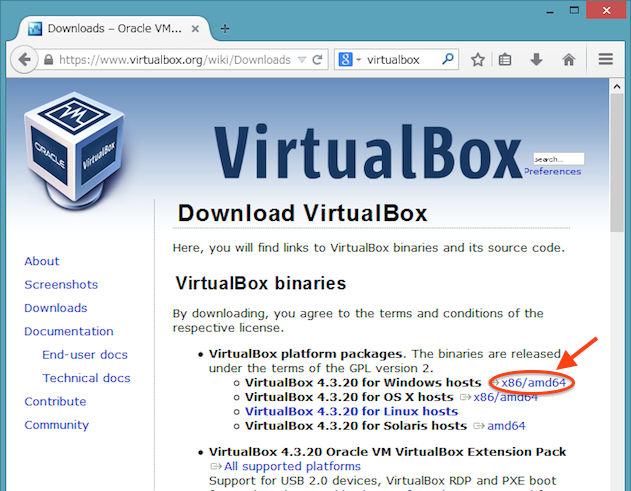
Start the downloaded setup program.

The setup program starts. Click the [Next] button.
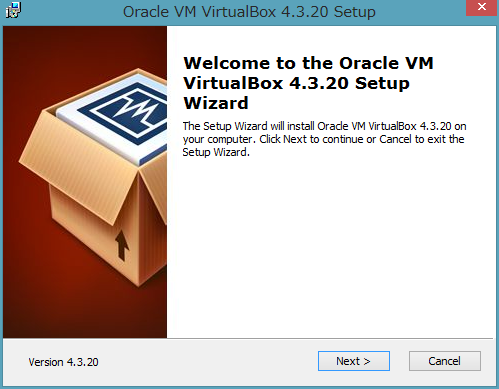
Customize the installation settings as required. Click the [Next] button.
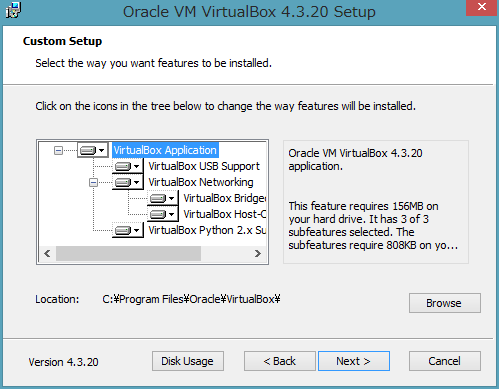
Choose the installation options as required. Click the [Next] button.
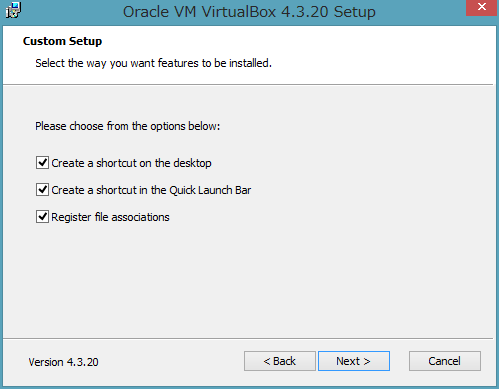
A message warning that the network connection will be interrupted is displayed. Click the [Yes] button.
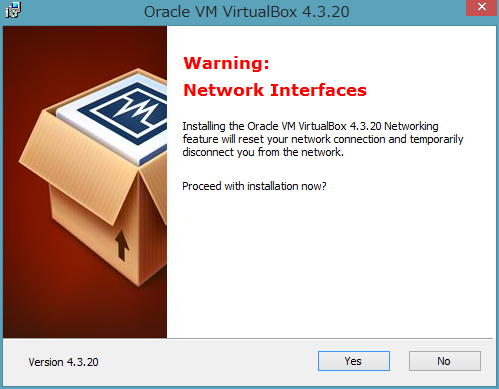
The final confirmation window before installation is displayed. Click the [Install] button.
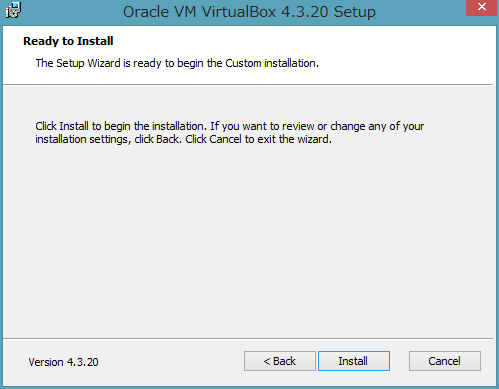
The dialog that confirms installation of the new device software is displayed several times. Click the [インストール] (Install) button.
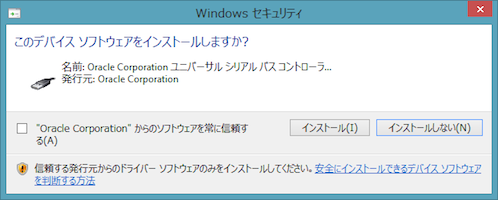
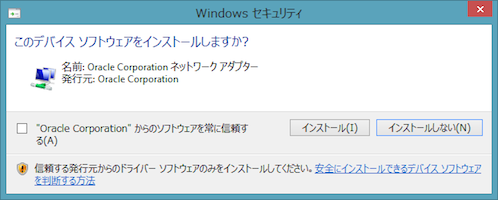

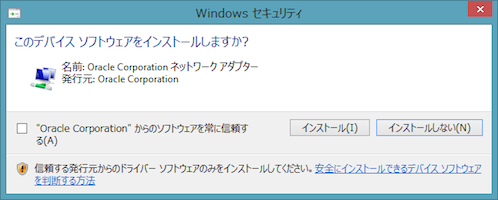
The window to finalize the installation is displayed. Click the [Finish] button.
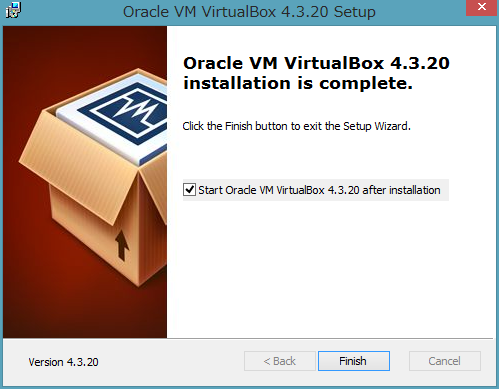
The installation of VirtualBox is now complete.
Installing the Linux Virtual Machine
Download the Ubuntu hard disk image from the official Ubuntu Japanese Team website.
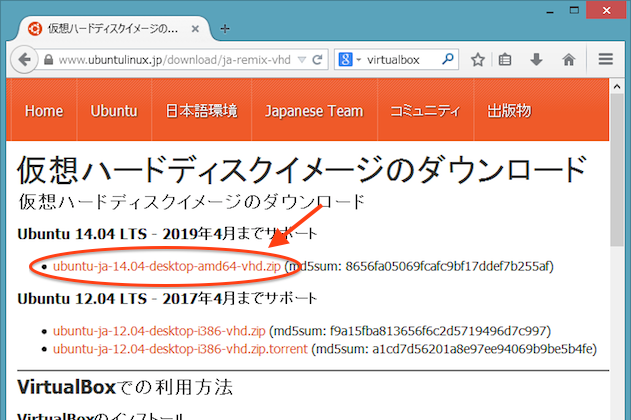
Unzip the downloaded file. A file called ubuntu-ja-14.04-desktop-amd64.vhd is created.
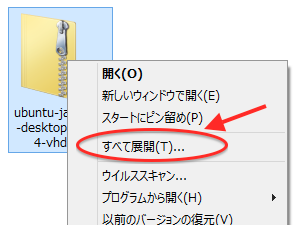
Start VirtualBox.

Click [新規] (New).
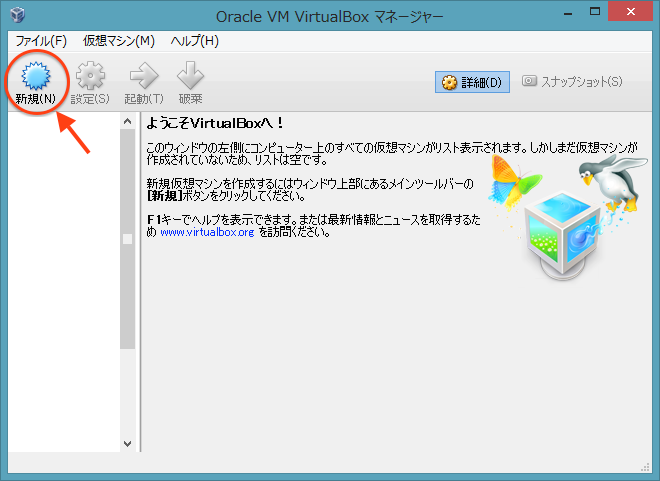
In the [名前] (Name) field, type ubuntu. Check the [タイプ] (Type) field shows Linux and the [バージョン] (Version) field shows Ubuntu (64 bit), and click the [次へ] (Next) button.
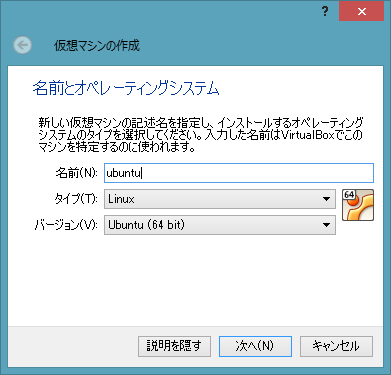
Set the Memory size to 1024 MB.
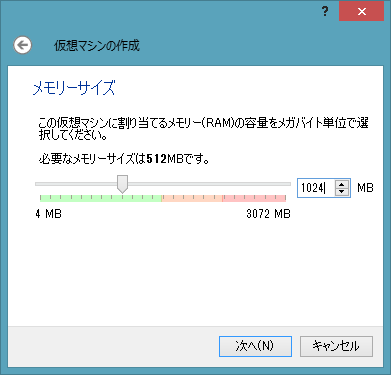
Select the [すでにある仮想ハードドライブファイルを使用する] (Use an existing virtual hard drive file) radio button and select the downloaded hard disk image in the pulldown menu. Click the [作成] (Create) button.
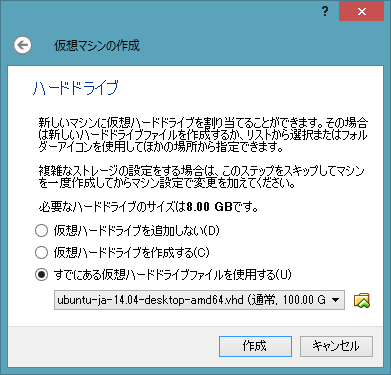
The virtual machine is now set up. To use the machine in the optimum manner, customize the virtual machine settings. Click [設定] (Settings).
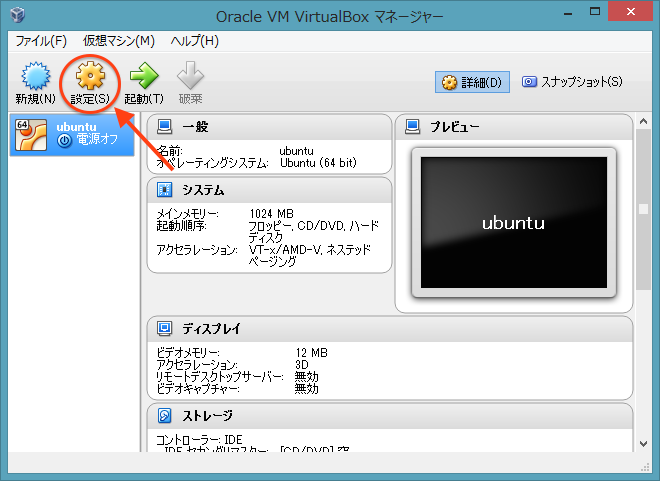
Click [ディスプレイ] (Display). In the [ビデオ] (Video) tab, select the [3Dアクセラレーションを有効化] (Enable 3D Acceleration) checkbox. Then click OK.
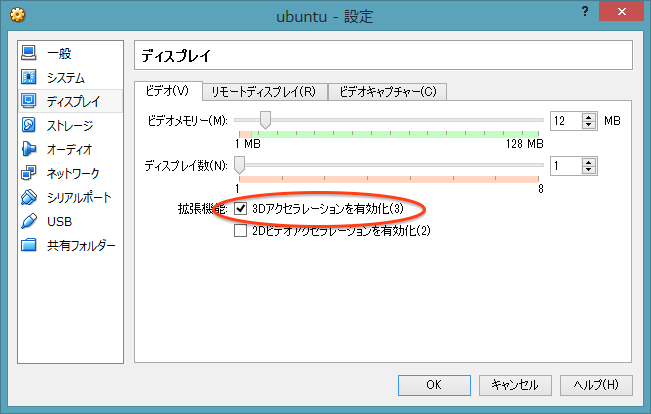
Now the Linux virtual machine has been installed.
Setting Up the Linux Virtual Machine
Start VirtualBox.

Start the Linux virtual machine.

Choose the language to use and click the [続ける] (Continue) button.
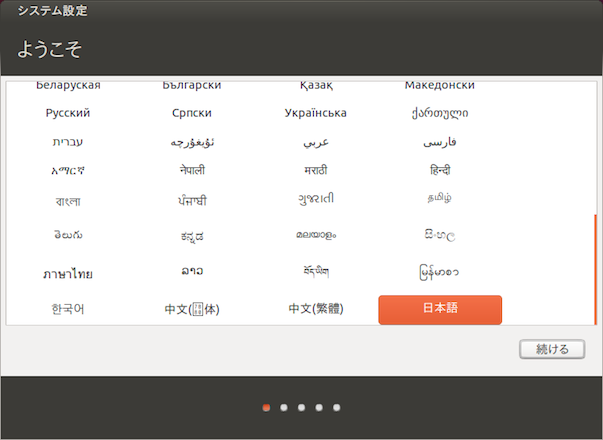
Choose your locale and click the [続ける] (Continue) button.
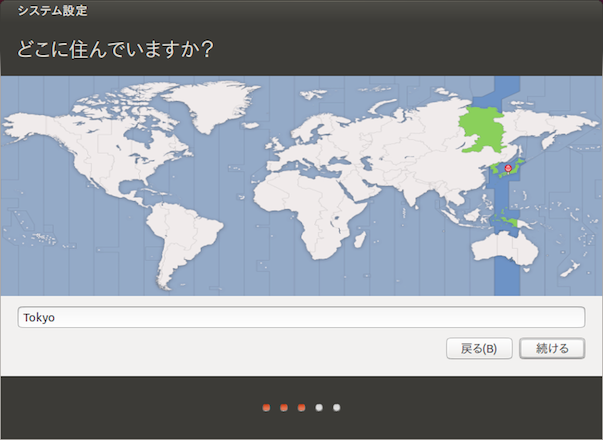
Choose your keyboard layout and click the [続ける] (Continue) button.
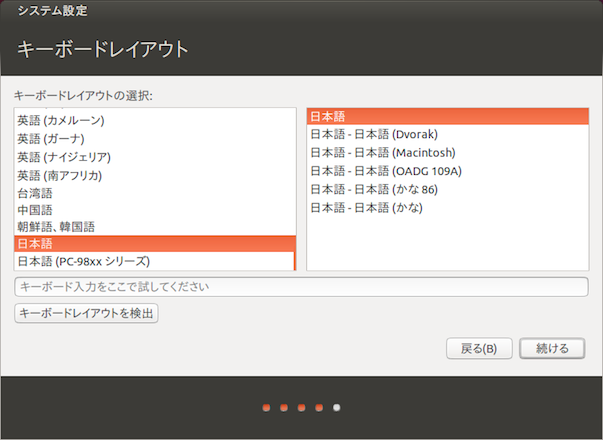
Input the information for the user and click the [続ける] (Continue) button.

Now the Linux virtual machine has been set up and is ready to connect to the HPC Cluster.
Connecting to the Server
Start VirtualBox.

Click [起動] (Start) to start the Linux virtual machine.

Linux starts. Type your password to log in.
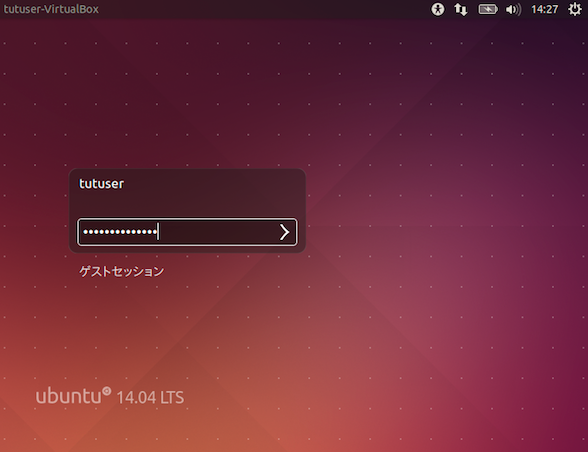
Click the icon shown at the top left of the window.
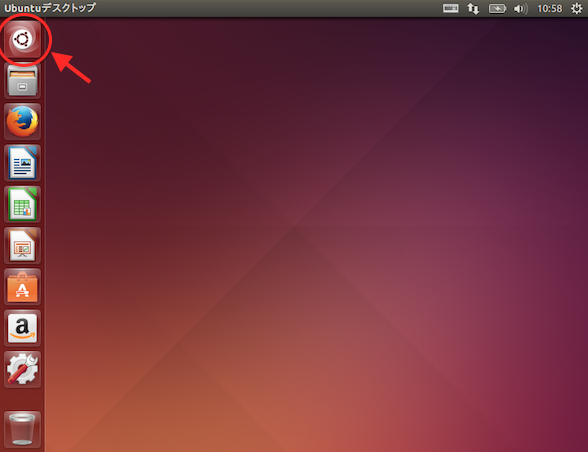
Type terminal.
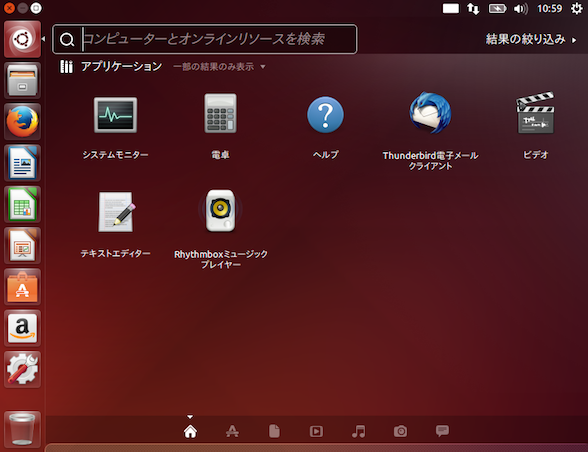
Click the [端末] (Terminal) icon.
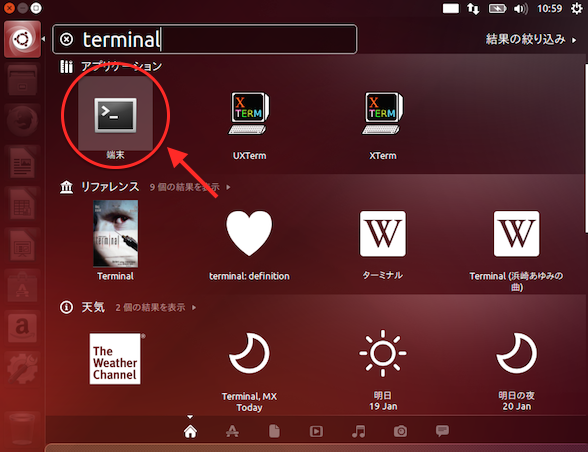
The terminal program starts. Perform the following steps in the terminal program.
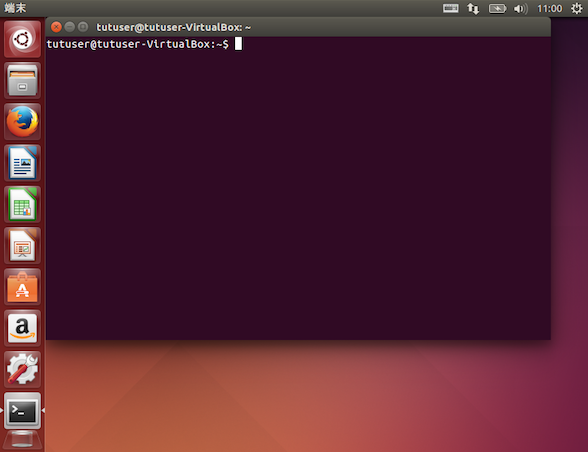
Type ssh <USER>@<SERVER> and press the Enter key to connect to the server. Replace <USER> with your own user name and <SERVER> with the target connection server.
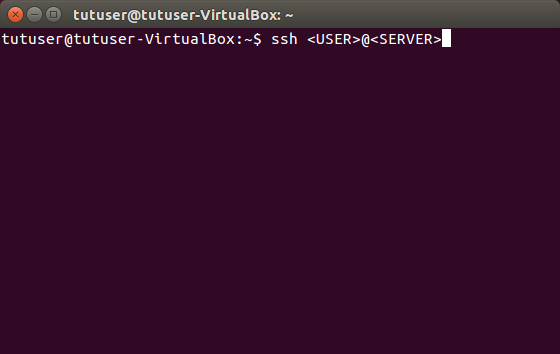
To execute the GUI application, input ssh -X <USER>@<SERVER>.
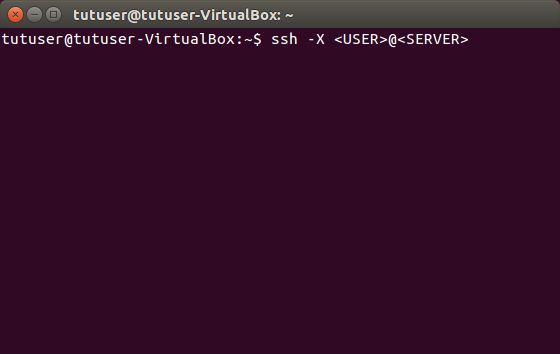
Supplement
Registering Shortcuts
Right-click the [端末] (Terminal) icon at the left of the window and select [Launcherに登録] (Keep in Launcher) to register the terminal as a shortcut. After this operation, you can launch the terminal just by clicking the [端末] (Terminal) icon at the left of the window.
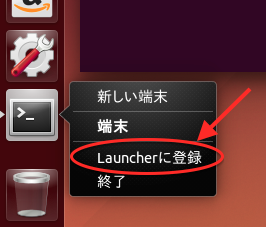
Closing the Virtual Machine
To close the virtual machine, click the cog icon shown at the top right of the window, and select [シャットダウン] (Shut Down).
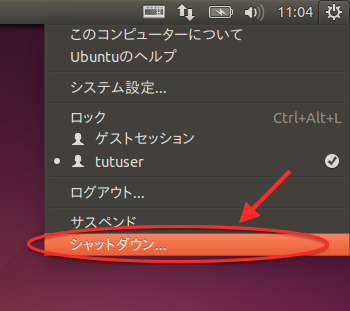
Then click the power button icon on the right.
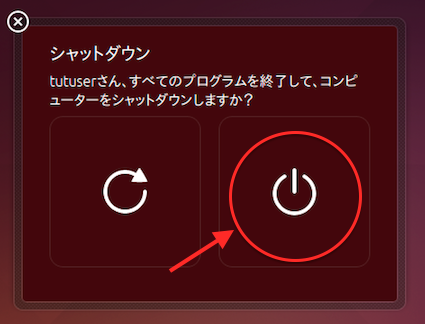
Creating a Public Key
You can create a public key as you can in Linux or Mac OS X. Click the link to refer to the details.